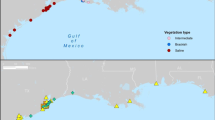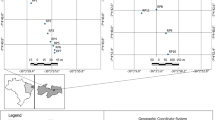Abstract
Periphyton communities play an important role in shallow lakes and are controlled by direct forces such as temperature, light, nutrients, and invertebrate grazing, but also indirectly by planktivorous fish predation. We performed a pan-European lake mesocosm experiment on periphyton colonization covering five countries along a north/south geographical/temperature gradient (Estonia, Germany, Czech Republic, Turkey, and Greece). Periphyton biomass on artificial polypropylene strips exposed at 50 cm water depth at low and high nutrient regimes (with mean total phosphorus concentration of 20 and 65 µg L−1, respectively) was compared during mid-summer. No significant effect of nutrient loading on periphyton biomass was observed as nutrient concentrations in the mesocosms were generally above limiting values. Water temperature significantly enhanced summer periphyton biomass development. Additionally, direct and indirect top-down control of snails and fish emerged as a significant factor in periphyton biomass control.





Similar content being viewed by others
References
Adrian R, Wilhelm S, Gerten D (2006) Life-history traits of lake plankton species may govern their phenological response to climate warming. Global Change Biol 12:652–661. doi:10.1111/j.1365-2486.2006.01125.x
Adrian R, O’Reilly CM, Zagarese H, Baines SB, Hessen DO, Keller W, Livingstone DM, Sommaruga R, Straile D, Van Donk E, Weyhenmeyer GA, Winder M (2009) Lakes as sentinels of climate change. Limnol Oceanogr 54:2283–2297. doi:10.4319/lo.2009.54.6_part_2.2283
Bécares E, Gomá J, Fernández-Aláez M, Fernández-Aláez C, Romo S, Miracle M, Ståhl-Delbanco A, Hansson L-A, Gyllström M, Bund W, Donk E, Kairesalo T, Hietala J, Stephen D, Balayla D, Moss B (2008) Effects of nutrients and fish on periphyton and plant biomass across a European latitudinal gradient. Aquat Ecol 42:561–574. doi:10.1007/s10452-007-9126-y
Beklioğlu M, Romo S, Kagalou I, Quintana X, Bécares E (2007) State of the art in the functioning of shallow Mediterranean lakes: workshop conclusions. Hydrobiologia 584:317–326. doi:10.1007/s10750-007-0577-x
Brönmark C (1989) Interactions between epiphytes, macrophytes and freshwater snails: a review. J Moll Stud 55:299–311. doi:10.1093/mollus/55.2.299
Brönmark C, Klosiewski SP, Stein RA (1992) Indirect effects of predation in a freshwater benthic food chain. Ecology 73:1662–1674. doi:10.2307/1940018
Cao Y, Li W, Jeppesen E (2014) The response of two submerged macrophyte and periphyton to elevated temperature at high nutrient level: a microcosm approach. Hydrobiologia 738:49–59. doi:10.1007/s10750-014-1914-5
Danger M, Lacroix G, Oumarou C, Benest D, Meriguet J (2008) Effects of food-web structure on periphyton stoichiometry in eutrophic lakes: a mesocosm study. Freshw Biol 53:2089–2100. doi:10.1111/j.1365-2427.2008.02031.x
González-Bergonzoni I, Meerhoff M, Davidson T, Teixeira-de Mello F, Baattrup-Pedersen A, Jeppesen E (2012) Meta-analysis shows a consistent and strong latitudinal pattern in fish omnivory across ecosystems. Ecosystems 15:492–503. doi:10.1007/s10021-012-9524-4
Gyllström M, Hansson LA, Jeppesen E, García-Criado F, Gross E, Irvine K, Kairesalo T, Kornijow R, Miracle MR, Nykänen M, Nõges T, Romo S, Stephen D, Van Donk E, Moss B (2005) The role of climate in shaping zooplankton communities of shallow lakes. Limnol Oceanogr 50:2008–2021. doi:10.4319/lo.2005.50.6.2008
Hansson LA (1992) Factors regulating periphytic algal biomass. Limnol Oceanogr 37:322–328
IPCC (2013) Summary for policymakers. In: Stocker TF, Qin D, Plattner GK, Tignor M, Allen SK, Boschung J, Nauels A, Xia Y, Bex V, Midgley PM, Midgley PM (eds) Climate change 2013: the physical science basis. Contribution of working group I to the fifth assessment report of the intergovernmental panel on climate change. Cambridge University Press, Cambridge, United Kingdom and New York, NY, USA
Jeppesen E, Jensen J, Søndergaard M, Lauridsen T, Pedersen L, Jensen L (1997) Top-down control in freshwater lakes: the role of nutrient state, submerged macrophytes and water depth. Hydrobiologia 342(343):151–164. doi:10.1023/a:1017046130329
Jones JI, Sayer CD (2003) Does the fish-invertebrate-periphyton cascade precipitate plant loss in shallow lakes? Ecology 84:2155–2167. doi:10.1890/02-0422
Kirk JTO (2010) Light and photosynthesis in aquatic ecosystems, 3rd edn. Cambridge University Press, Cambridge
Körner S, Dugdale T (2003) Is roach herbivory preventing re-colonization of submerged macrophytes in a shallow lake? Hydrobiologia 506(509):497–501. doi:10.1023/B:HYDR.0000008561.67513.ec
Lalonde S, Downing JA (1991) Epiphyton biomass is related to lake trophic status, depth, and macrophyte architecture. Can J Fish Aquat Sci 48:2285–2291. doi:10.1139/f91-268
Landkildehus F, Søndergaard M, Beklioglu M, Adrian R, Angeler DG, Hejzlar J, Papastergiadou E, Zingel P, Çakiroğlu Aİ, Scharfenberger U, Drakare S, Nõges T, Šorf M, Stefanidis K, Tavşanoğlu ÜN, Trigal C, Mahdy A, Papadaki C, Tuvikene L, Kernan M, Jeppesen E (2014) Climate change effects on shallow lakes: design and preliminary results of a cross-European climate gradient mesocosm experiment. Estonian J Ecol 63:71–89. doi:10.3176/eco.2014.2.02
Liboriussen L, Jeppesen E (2006) Structure, biomass, production and depth distribution of periphyton on artificial substratum in shallow lakes with contrasting nutrient concentrations. Freshw Biol 51:95–109. doi:10.1111/j.1365-2427.2005.01481.x
Liboriussen L, Jeppesen E, Bramm M, Lassen M (2005) Periphyton-macroinvertebrate interactions in light and fish manipulated enclosures in a clear and a turbid shallow lake. Aquat Ecol 39:23–39. doi:10.1007/s10452-004-3039-9
Liess A, Haglund AL (2007) Periphyton responds differentially to nutrients recycled in dissolved or faecal pellet form by the snail grazer Theodoxus fluviatilis. Freshw Biol 52:1997–2008. doi:10.1111/j.1365-2427.2007.01825.x
Livingstone DM, Lotter AF (1998) The relationship between air and water temperatures in lakes of the Swiss Plateau: a case study with palaeolimnological implications. J Paleolimnol 19:181–198. doi:10.1023/A:1007904817619
McCombie AM (1959) Some relations between air temperatures and the surface water temperature of lakes. Limnol Oceanogr 4:252–258. doi:10.4319/lo.1959.4.3.0252
McKee D, Hatton K, Eaton JW, Atkinson D, Atherton A, Harvey I, Moss B (2002) Effects of simulated climate warming on macrophytes in freshwater microcosm communities. Aquat Bot 74:71–83. doi:10.1016/S0304-3770(02)00048-7
Meerhoff M, Clemente JM, De Mello FT, Iglesias C, Pedersen AR, Jeppesen E (2007) Can warm climate-related structure of littoral predator assemblies weaken the clear water state in shallow lakes? Glob Change Biol 13:1888–1897. doi:10.1111/j.1365-2486.2007.01408.x
Meerhoff M, Teixeira-de Mello F, Kruk C, Alonso C, González-Bergonzoni I, Pacheco JP, Lacerot G, Arim M, Beklioğlu M, Brucet S, Goyenola G, Iglesias C, Mazzeo N, Kosten S, Jeppesen E (2012) Environmental warming in shallow lakes: a review of potential changes in community structure as evidenced from space-for-time substitution approaches. In: Jacob U, Woodward G (eds) Global change in multispecies systems part 1. Advances in ecological research, vol 46. Academic Press, pp 259–349. http://www.sciencedirect.com/science/article/pii/B9780123969927000046
Mooij WM, Hülsmann S, De Senerpont Domis L, Nolet B, Bodelier PE, Boers PM, Pires LM, Gons H, Ibelings B, Noordhuis R, Portielje R, Wolfstein K, Lammens ERR (2005) The impact of climate change on lakes in the Netherlands: a review. Aquat Ecol 39:381–400. doi:10.1007/s10452-005-9008-0
Mooij WM, De Senerpont DL, Hülsmann S (2008) The impact of climate warming on water temperature, timing of hatching and young-of-the-year growth of fish in shallow lakes in the Netherlands. J Sea Res 60:32–43. doi:10.1016/j.seares.2008.03.002
Offill YA, Walton WE (1999) Comparative efficacy of the threespine stickleback (Gasterosteus aculeatus) and the mosquitofish (Gambusia affinis) for mosquito control. J Am Mosq Control Assoc 15:380–390
Papastergiadou E, Kagalou I, Stefanidis K, Retalis A, Leonardos I (2010) Effects of anthropogenic influences on the trophic state, land uses and aquatic vegetation in a shallow Mediterranean lake: implications for restoration. Water Resour Manage 24:415–435. doi:10.1007/s11269-009-9453-y
Patrick DA, Boudreau N, Bozic Z, Carpenter GS, Langdon DM, LeMay SR, Martin SM, Mourse RM, Prince SL, Quinn KM (2012) Effects of climate change on late-season growth and survival of native and non-native species of watermilfoil (Myriophyllum spp.): implications for invasive potential and ecosystem change. Aquat Bot 103:83–88. doi:10.1016/j.aquabot.2012.06.008
Phillips GL, Eminson D, Moss B (1978) A mechanism to account for macrophyte decline in progressively eutrophicated freshwaters. Aquat Bot 4:103–126. doi:10.1016/0304-3770(78)90012-8
Roberts E, Kroker J, Körner S, Nicklisch A (2003) The role of periphyton during the re-colonization of a shallow lake with submerged macrophytes. Hydrobiologia 506–509:525–530. doi:10.1023/B:HYDR.0000008560.73832.1c
Sánchez-Gonzáles S, Ruiz-Campos G, Contreras-Balderas S (2001) Feeding ecology and habitat of the threespine stickleback, Gasterosteus aculeatus microcephalus, in a remnant population of northwestern Baja California, México. Ecol Freshw Fish 10:191–197. doi:10.1034/j.1600-0633.2001.100401.x
Sand-Jensen K, Borum J (1991) Interactions among phytoplankton, periphyton, and macrophytes in temperate freshwaters and estuaries. Aquat Bot 41:137–175. doi:10.1016/0304-3770(91)90042-4
Scheffer M, Hosper SH, Meijer ML, Moss B, Jeppesen E (1993) Alternative equilibria in shallow lakes. Trends Ecol Evol 8:275–279. doi:10.1016/0169-5347(93)90254-M
Seebens H, Einsle U, Straile D (2009) Copepod life cycle adaptations and success in response to phytoplankton spring bloom phenology. Glob Change Biol 15:1394–1404. doi:10.1111/j.1365-2486.2008.01806.x
Shurin JB, Clasen JL, Greig HS, Kratina P, Thompson PL (2012) Warming shifts top-down and bottom-up control of pond food web structure and function. Phil T R Soc B-Biol Sci 367(1605):3008–3017. doi:10.1098/rstb.2012.0243
Simpson NP (2008) The potential impact on mosquito larvae by threespine stickleback (Gasterosteus aculeatus) and mosquitofish (Gambusia affinis) in four constructed wetlands. Thesis (M.S.)—Humboldt State University, Fisheries: Wastewater Utilization, p 82
Tarkowska-Kukuryk M, Mieczan T (2012) Effect of substrate on periphyton communities and relationships among food web components in shallow hypertrophic lake. J Limnol 71:279–290. doi:10.4081/jlimnol.2012.e30
Teixeira-de Mello F, Meerhoff M, Pekcan-Hekim Z, Jeppesen E (2009) Substantial differences in littoral fish community structure and dynamics in subtropical and temperate shallow lakes. Freshw Biol 54:1202–1215. doi:10.1111/j.1365-2427.2009.02167.x
Trochine C, Guerrieri M, Liboriussen L, Lauridsen TL, Jeppesen E (2014) Effects of nutrient loading, temperature regime and grazing pressure on nutrient limitation of periphyton in experimental ponds. Freshw Biol 59:905–917. doi:10.1111/fwb.12314
Wagner C, Adrian R (2009) Exploring lake ecosystems: hierarchy responses to long-term change? Glob Change Biol 15:1104–1115. doi:10.1111/j.1365-2486.2008.01833.x
Acknowledgments
This project was primarily supported by the EU FP-7 Theme 6 project REFRESH (Adaptive strategies to Mitigate the Impacts of Climate Change on European Freshwater Ecosystems, Contract No.: 244121). EJ, MS, and FL were also supported by ‘CLEAR’ (a Villum Kann Rasmussen Centre of Excellence project), CRES, and CIRCE. In addition, JH and MS obtained support from the MSMT CR (project No. 425 7E11059) and NF was supported by TÜBİTAK 2211 Scholarship programme, and the study was partly supported by TÜBITAK (ÇAYDAĞ110Y125). AM was supported by a PhD426 stipend from the Egyptian Government. Support also came from the Estonian Ministry of Education (SF 0170011s08) and Estonian Science Foundation grants 8729 and 9102, and EP, KS, and CP were supported by grants from the University of Patras. We want to thank Arvo Tuvikene, Tõnu Feldmann, Helen Agasild, Anu Kisand, Katrit Karus, Şeyda Erdoğan, Tuba Bucak, Eti Levi, Gizem Bezirci, Arda Özen, Engin Bilgen, Tasos Samiotis, and Yannis Nikolopoulos for help with setting up the experiment, nursing the imported fish, and undertaking the regular sampling. The local fishermen in Lake Lysimachia are acknowledged for keeping the mesocosm construction safe. The Erken Field laboratory and the technicians of the Department of Aquatic Sciences and Assessment (SLU) also provided invaluable help. The IGB provided additional funding for the experimental set-up. We thank the staff at IGB for their tremendous technical support during the set-up of the experiments, sampling, and sample processing; especially Thomas Hintze. We also thank Armaplast Co. for constructing the mesocosms and ensuring their safe transport to all the experimental sites. Anne Mette Poulsen’s linguistic improvements are acknowledged. The map of Europe in Fig. 1 was provided by Natural Earth and customized with QGIS 2.0.1-Dufour.
Author information
Authors and Affiliations
Corresponding author
Electronic supplementary material
Below is the link to the electronic supplementary material.
Rights and permissions
About this article
Cite this article
Mahdy, A., Hilt, S., Filiz, N. et al. Effects of water temperature on summer periphyton biomass in shallow lakes: a pan-European mesocosm experiment. Aquat Sci 77, 499–510 (2015). https://doi.org/10.1007/s00027-015-0394-7
Received:
Accepted:
Published:
Issue Date:
DOI: https://doi.org/10.1007/s00027-015-0394-7




